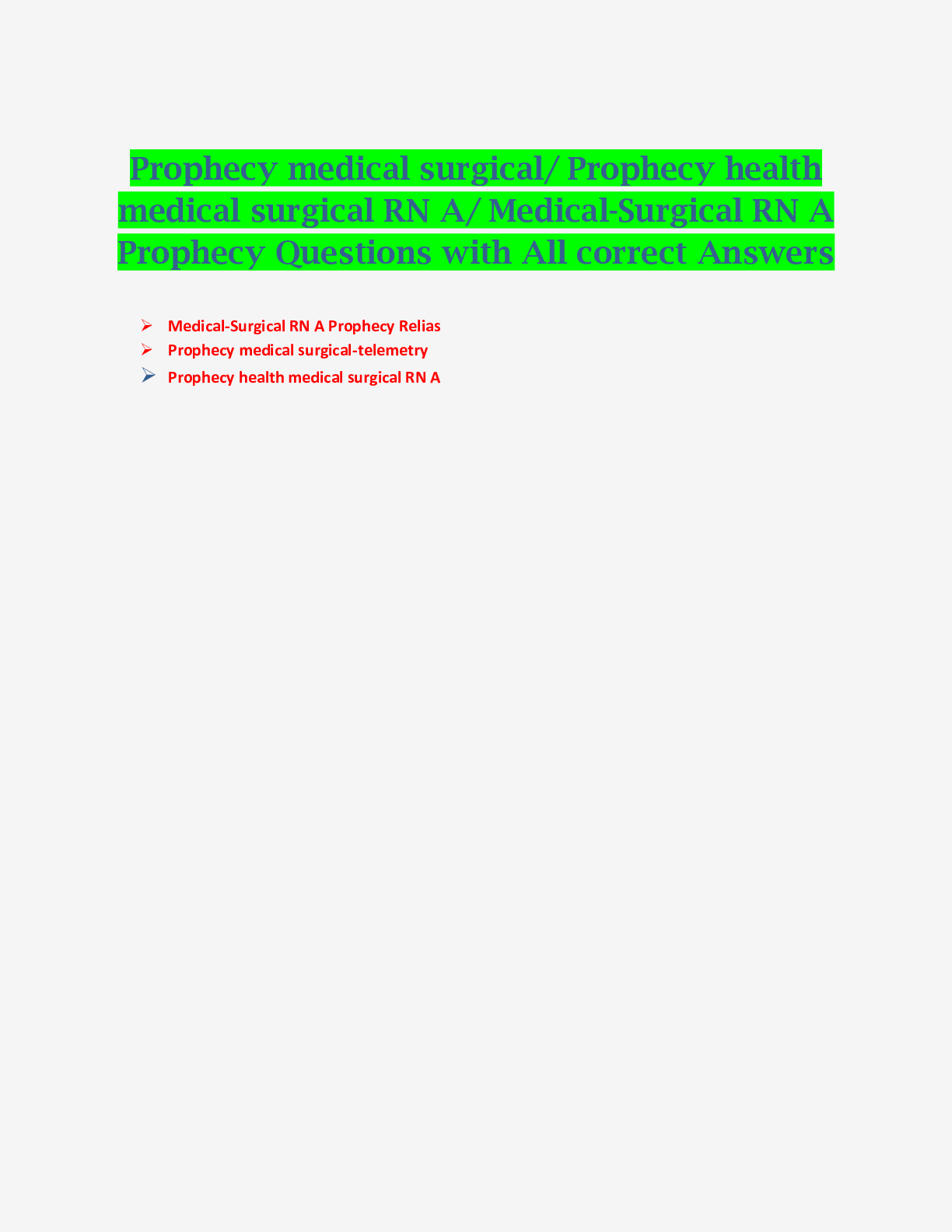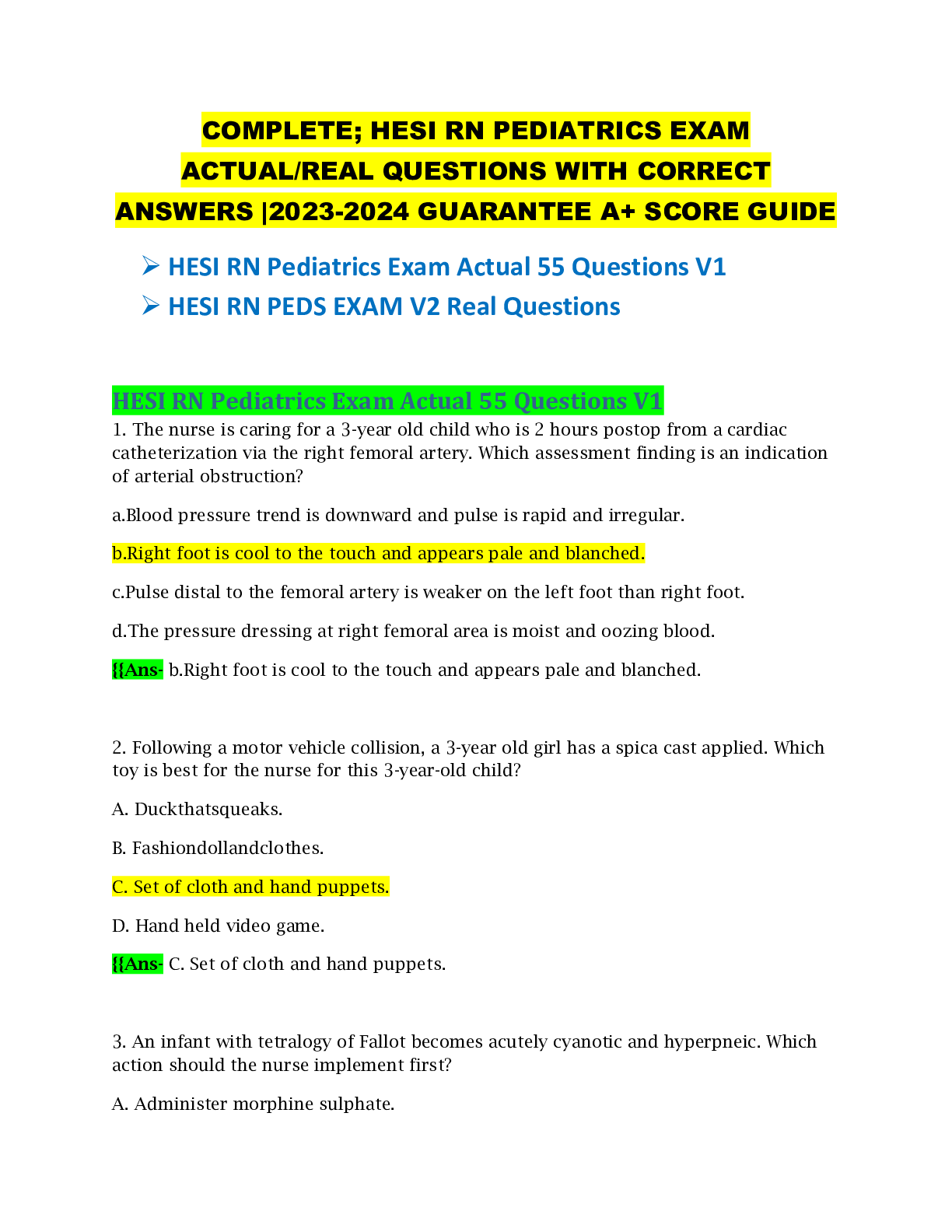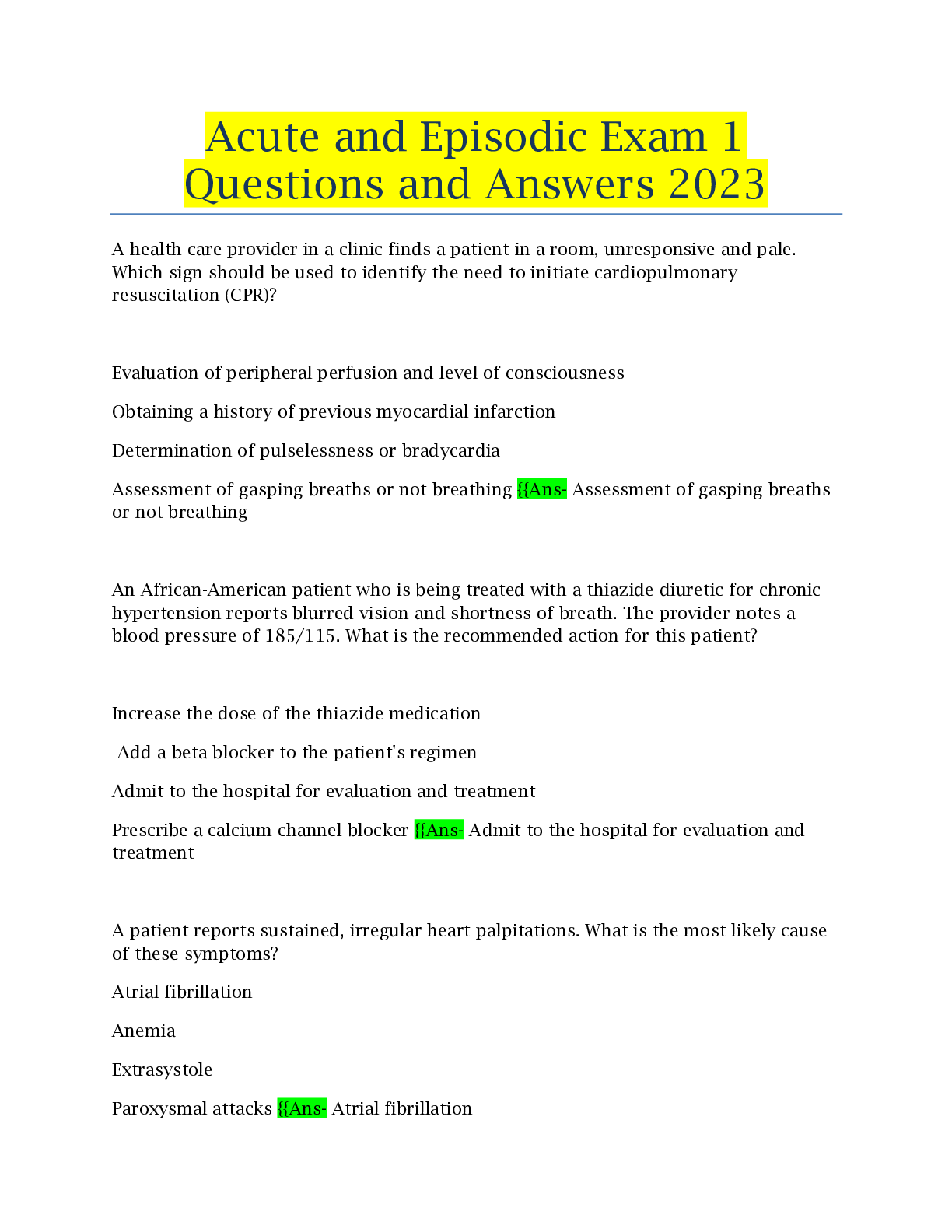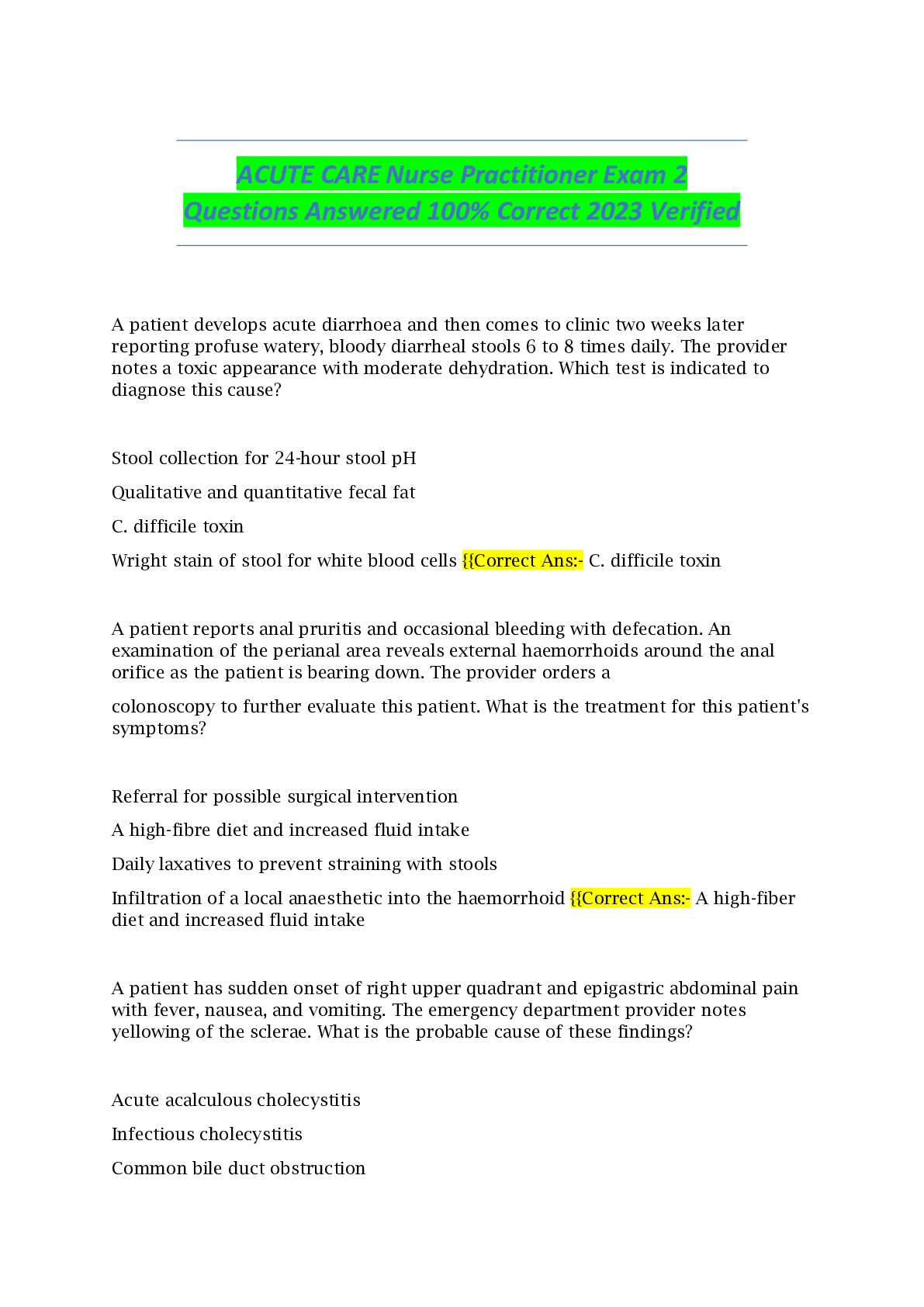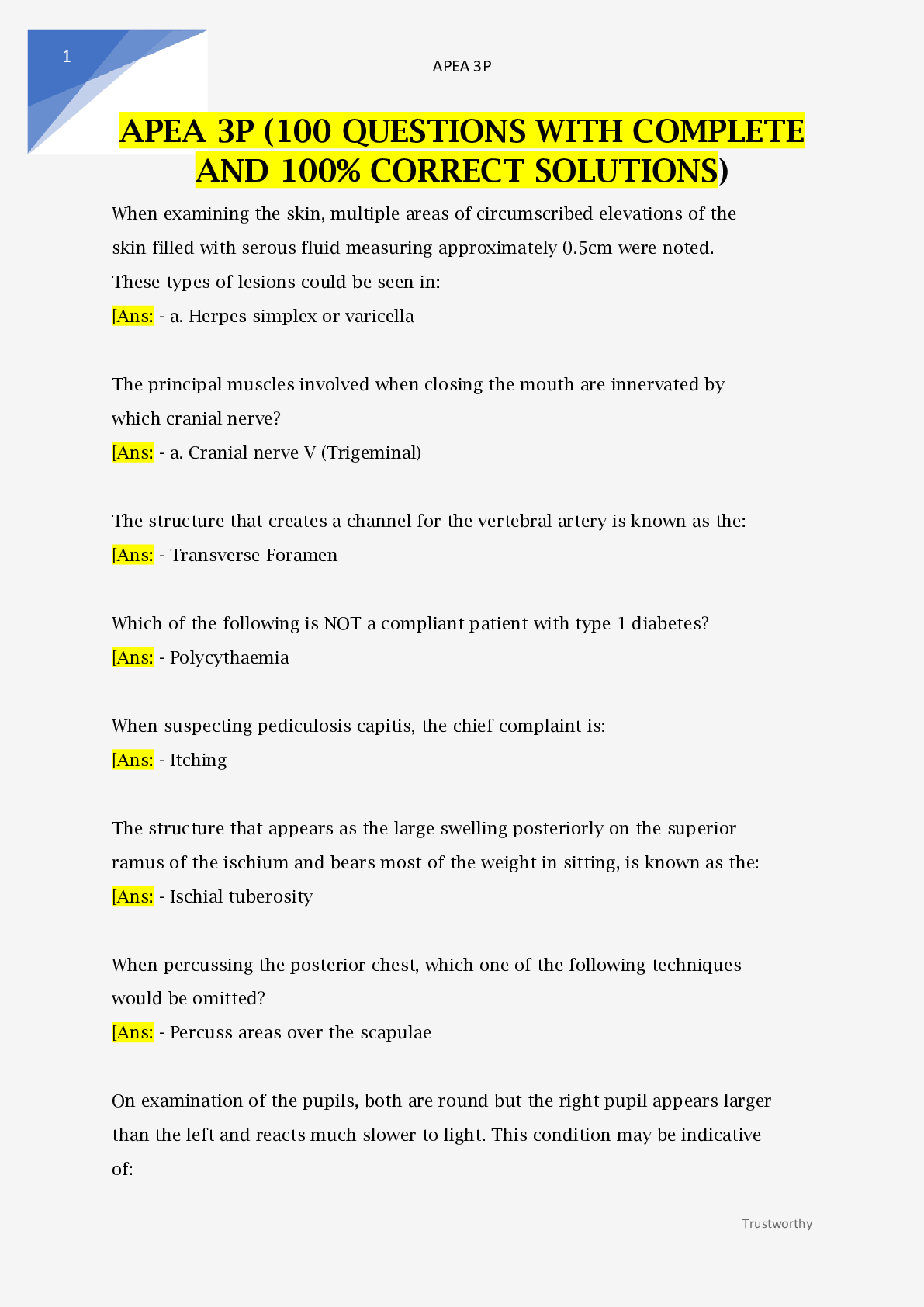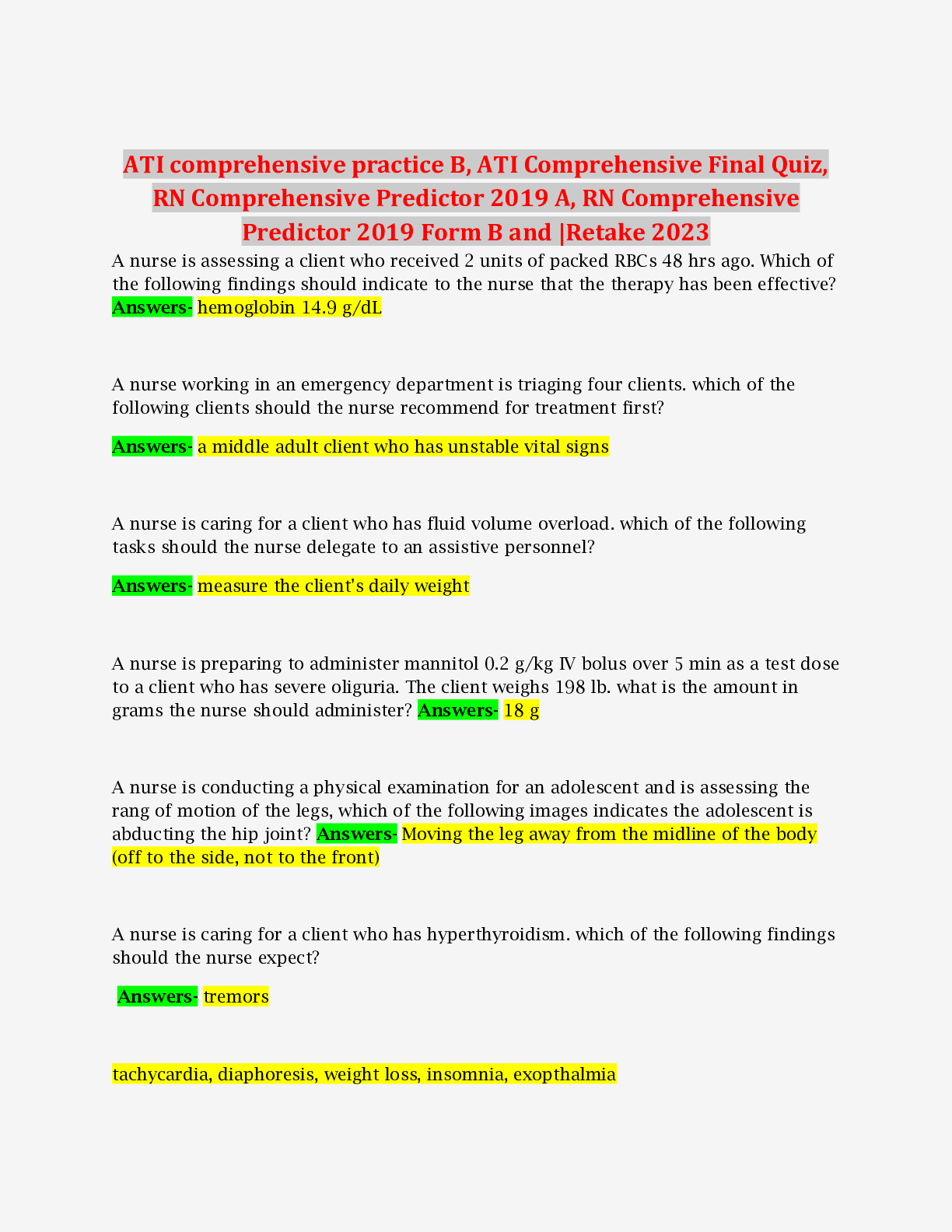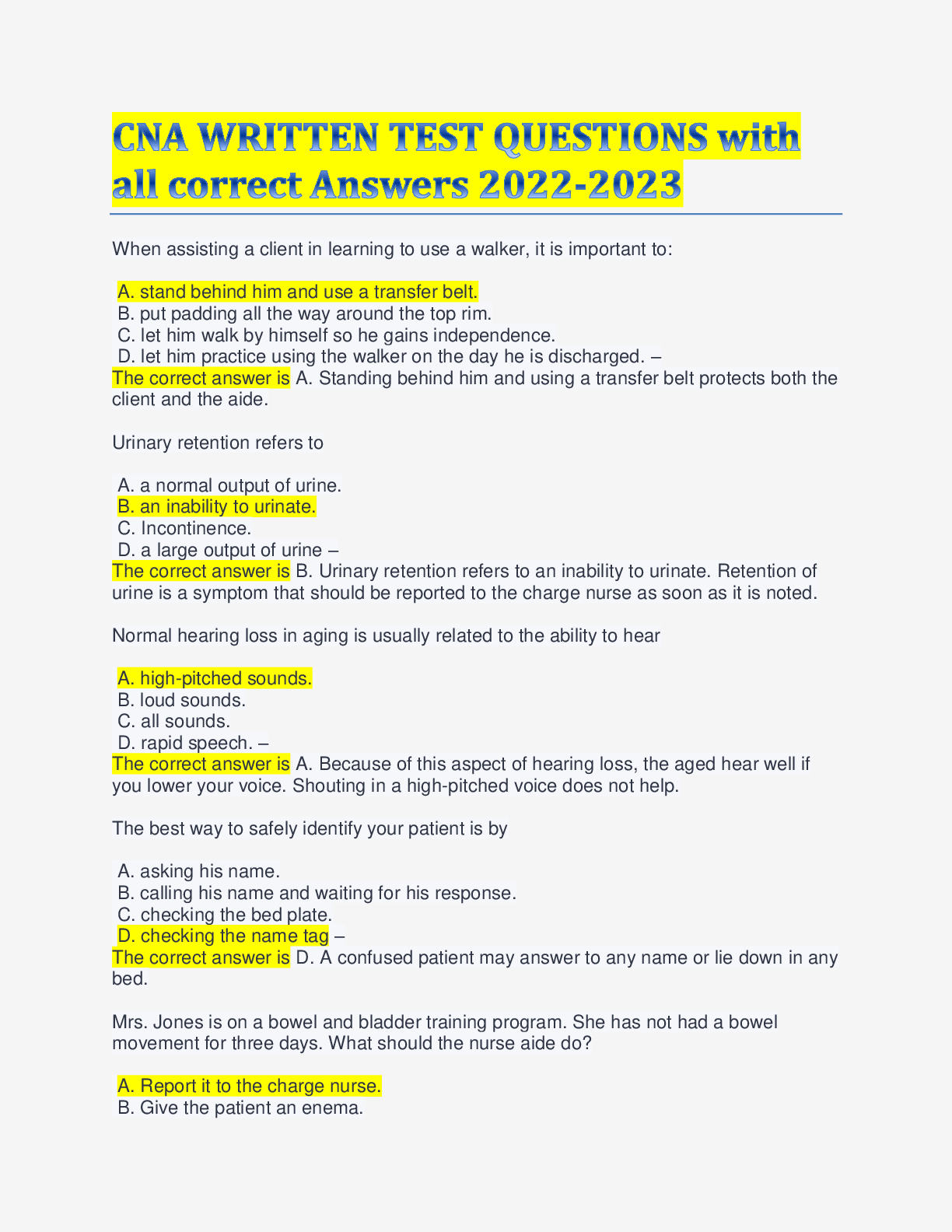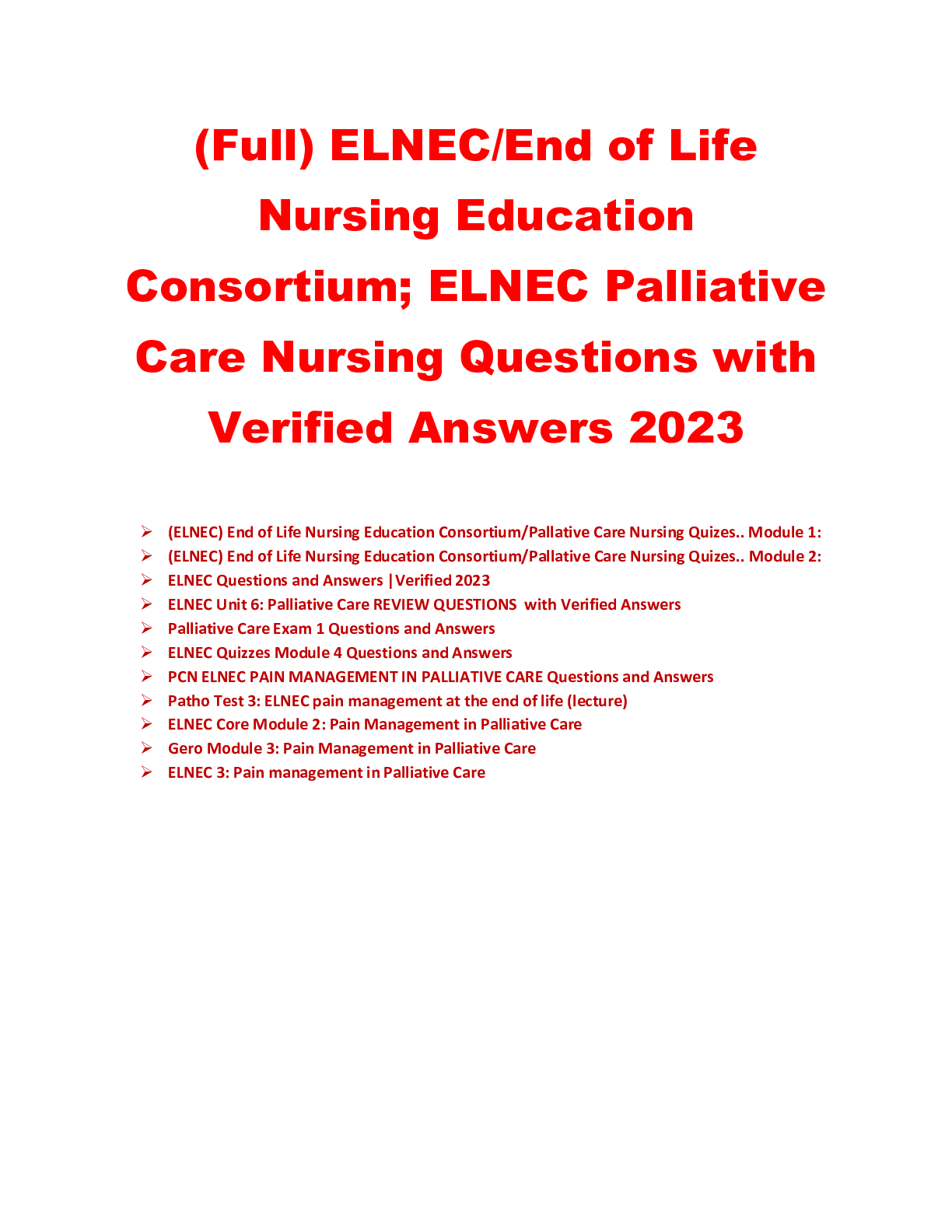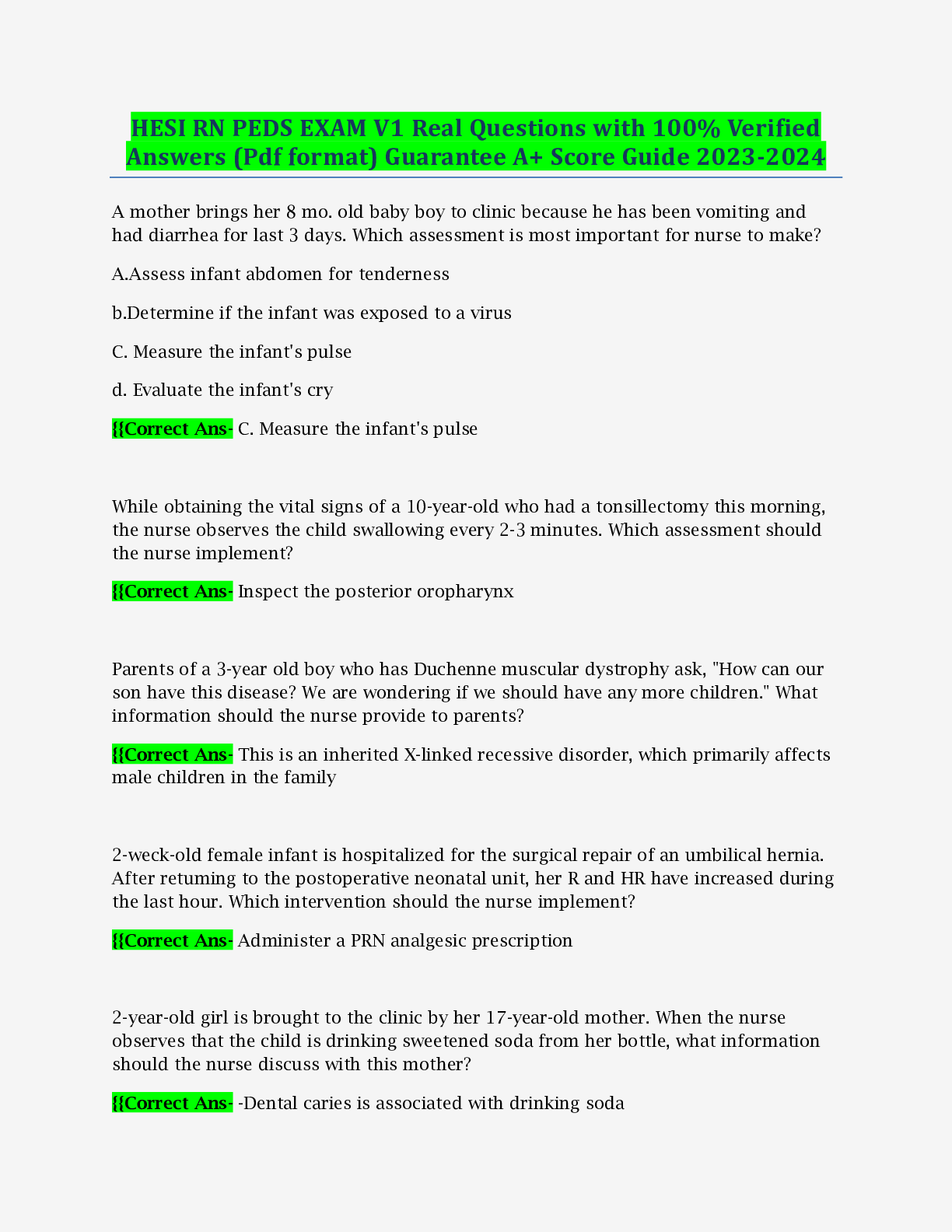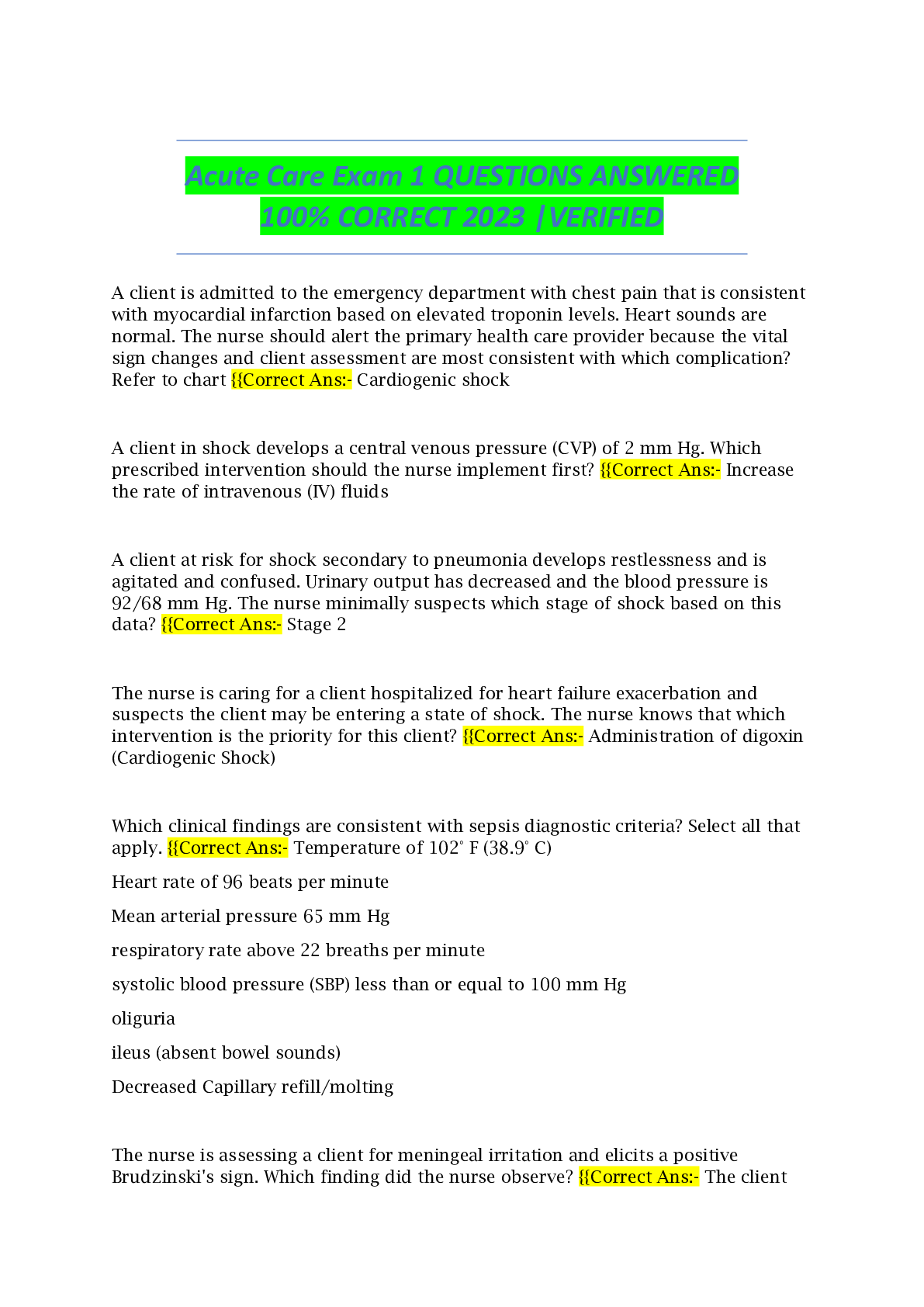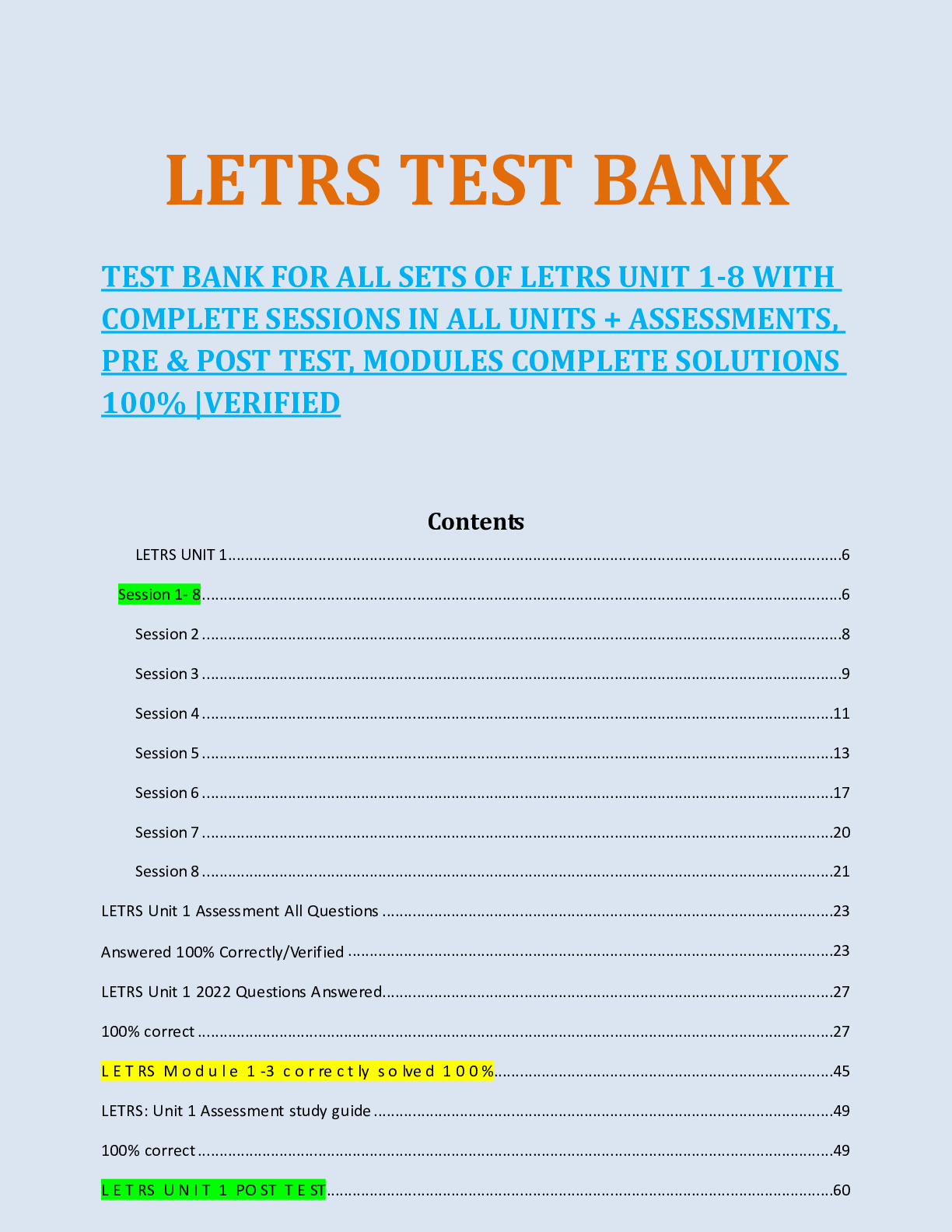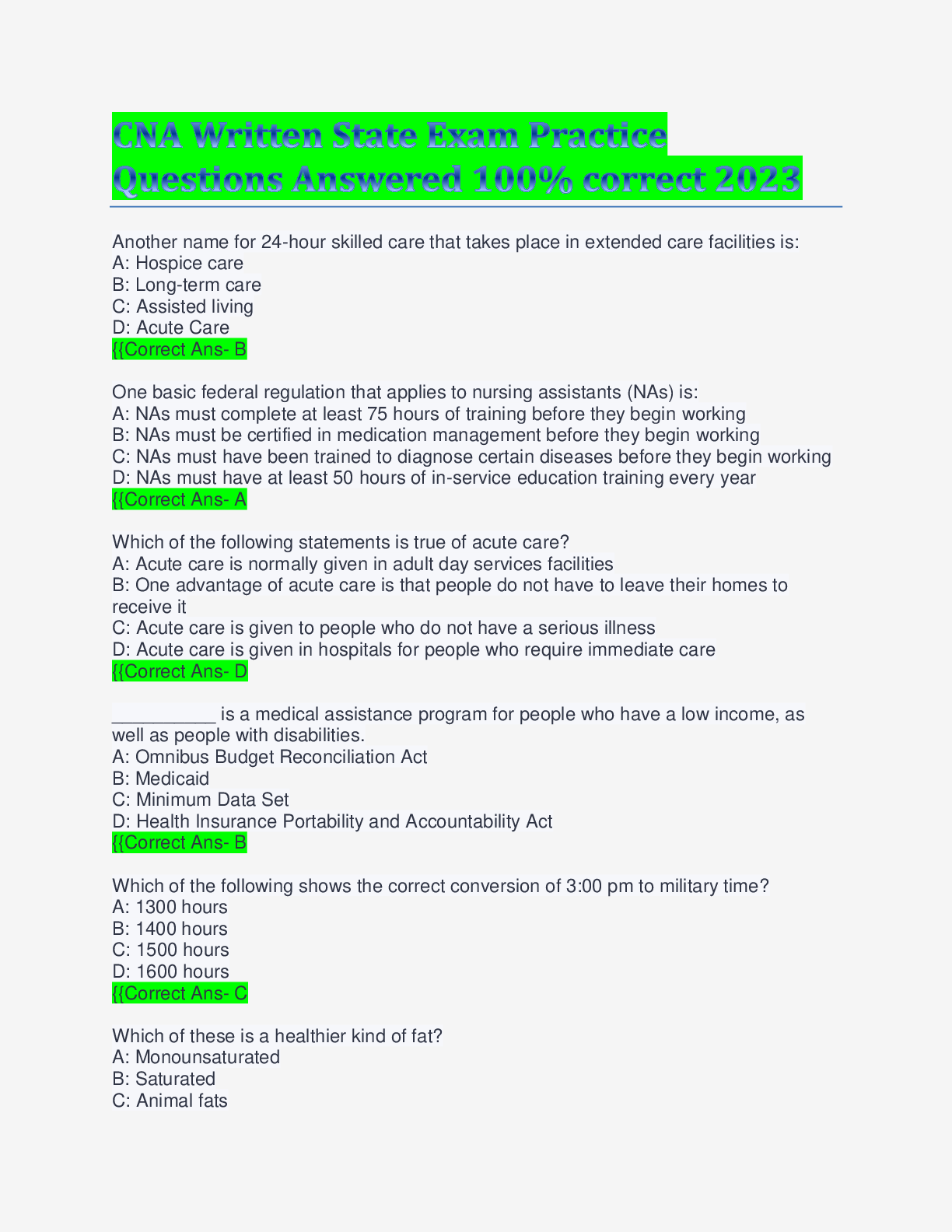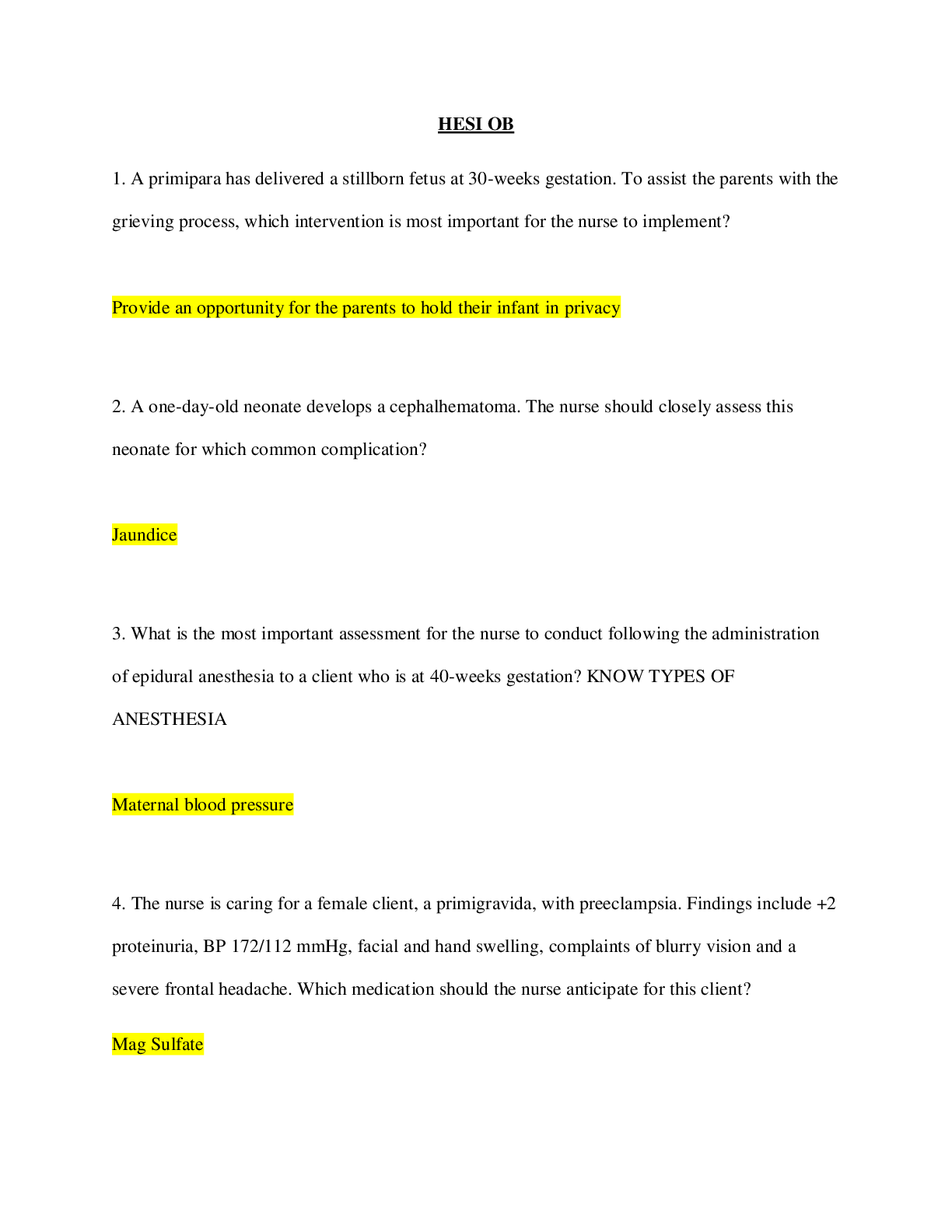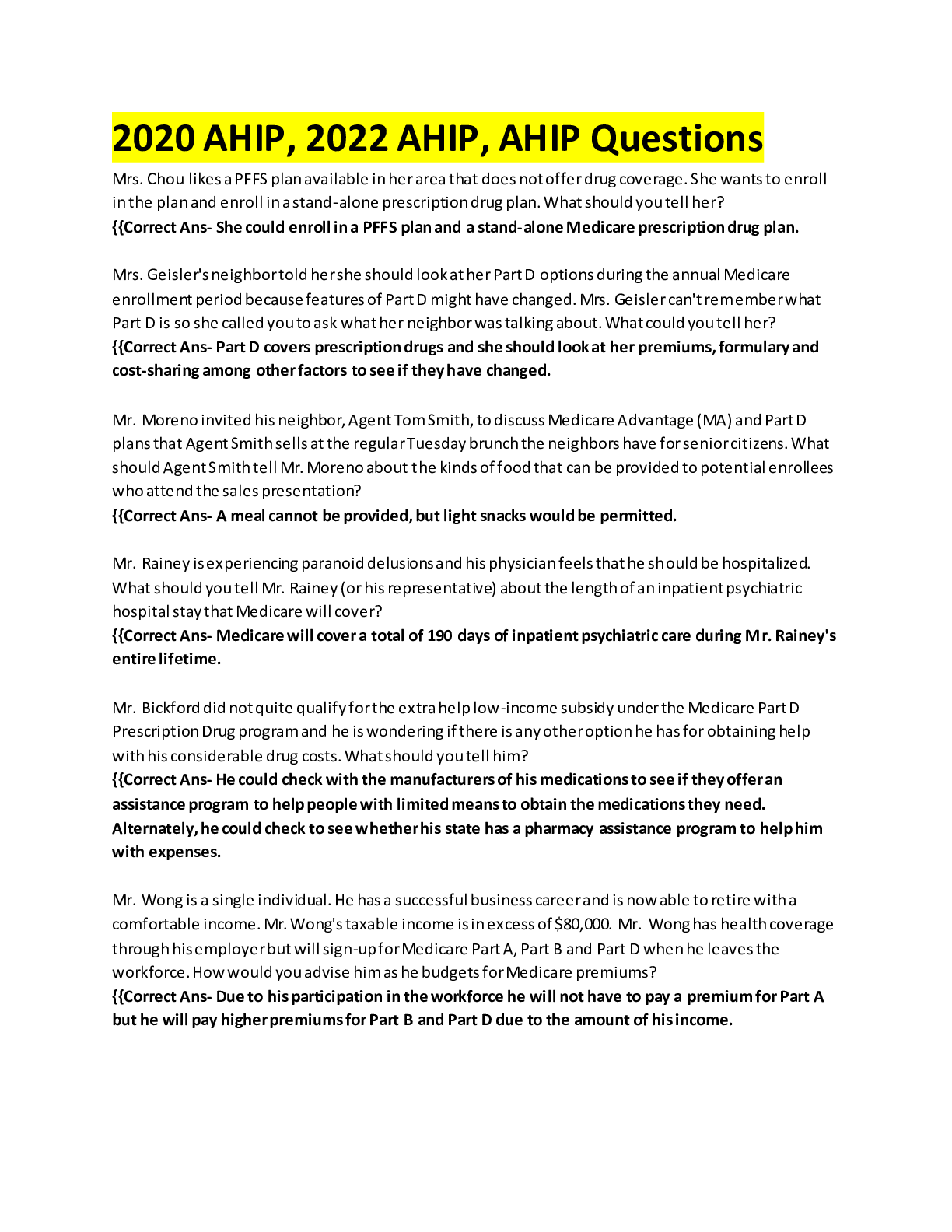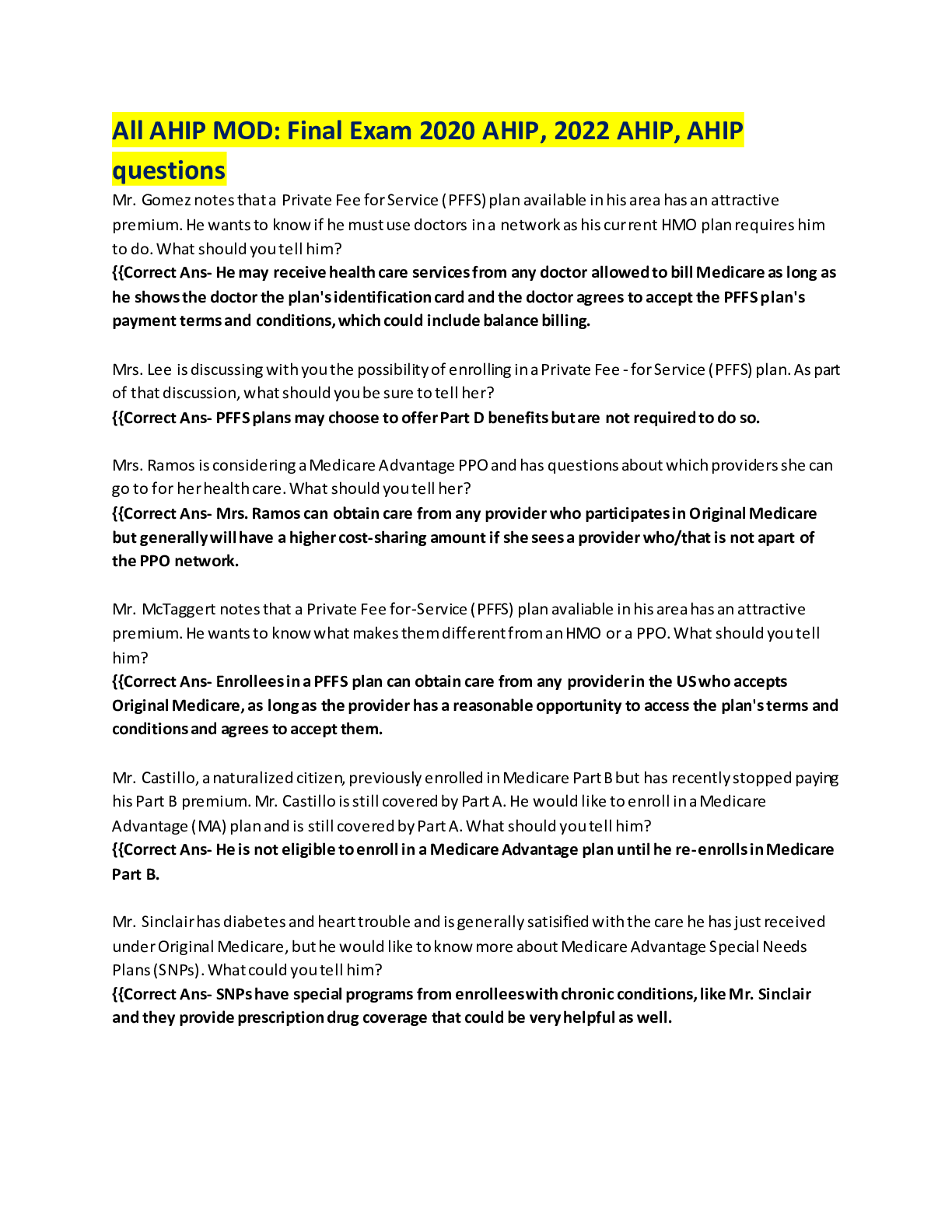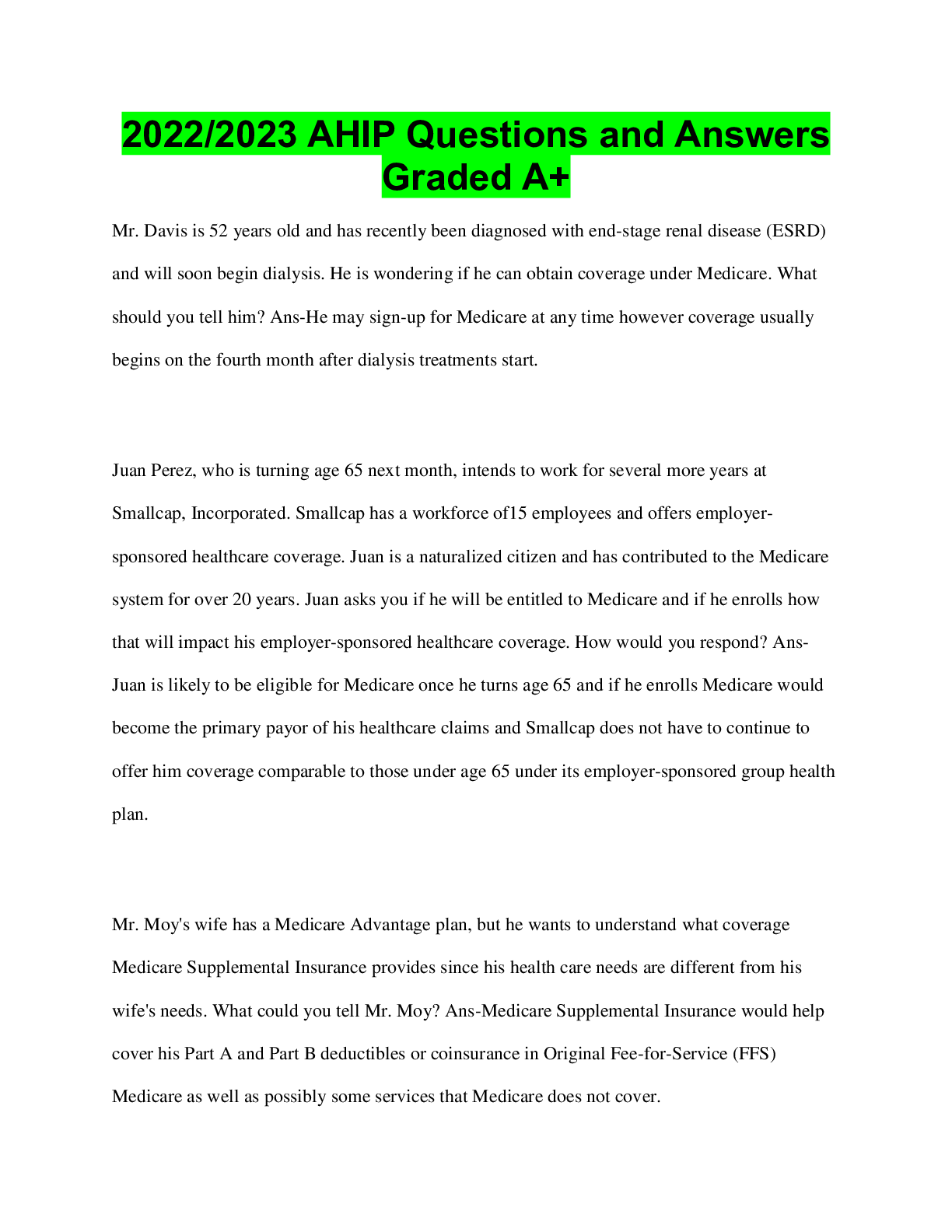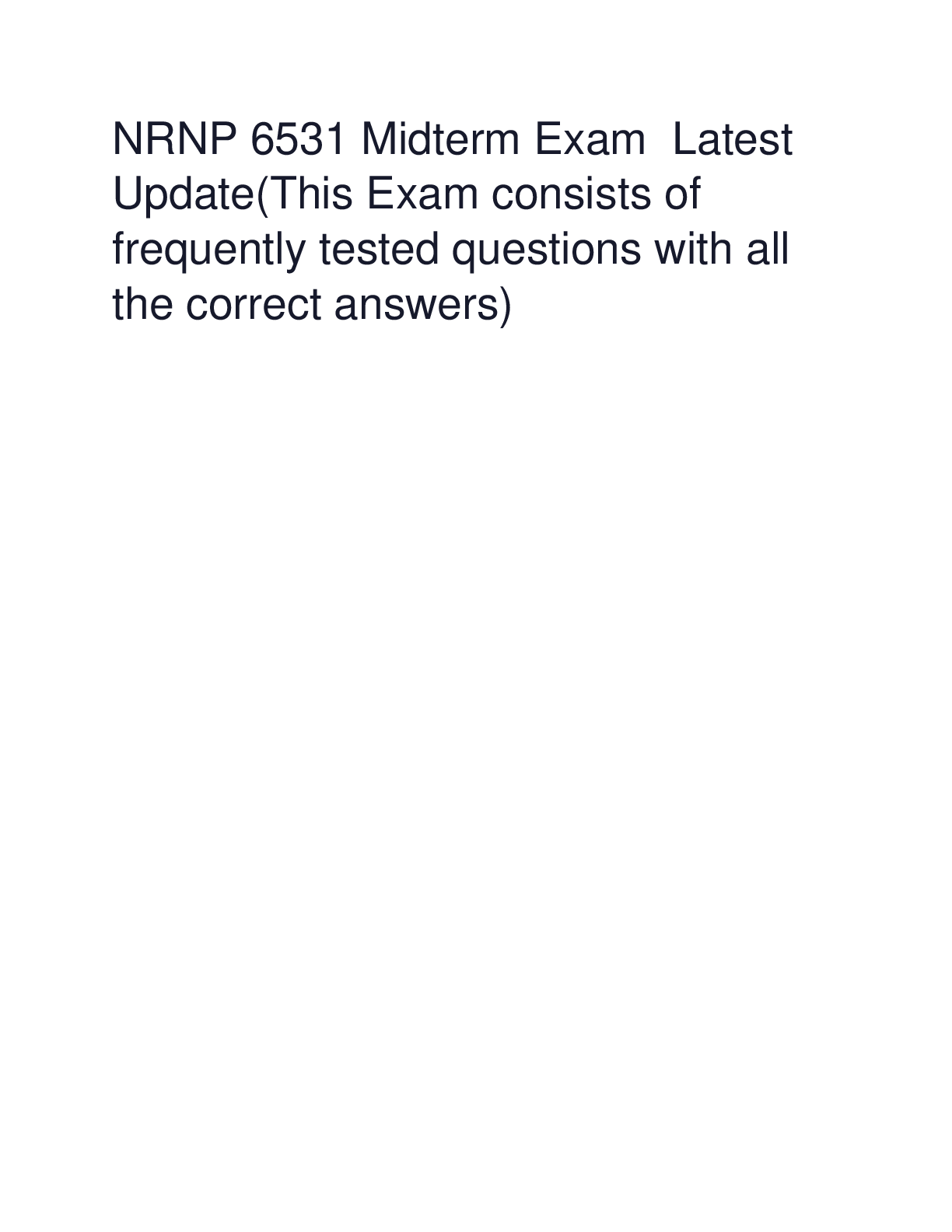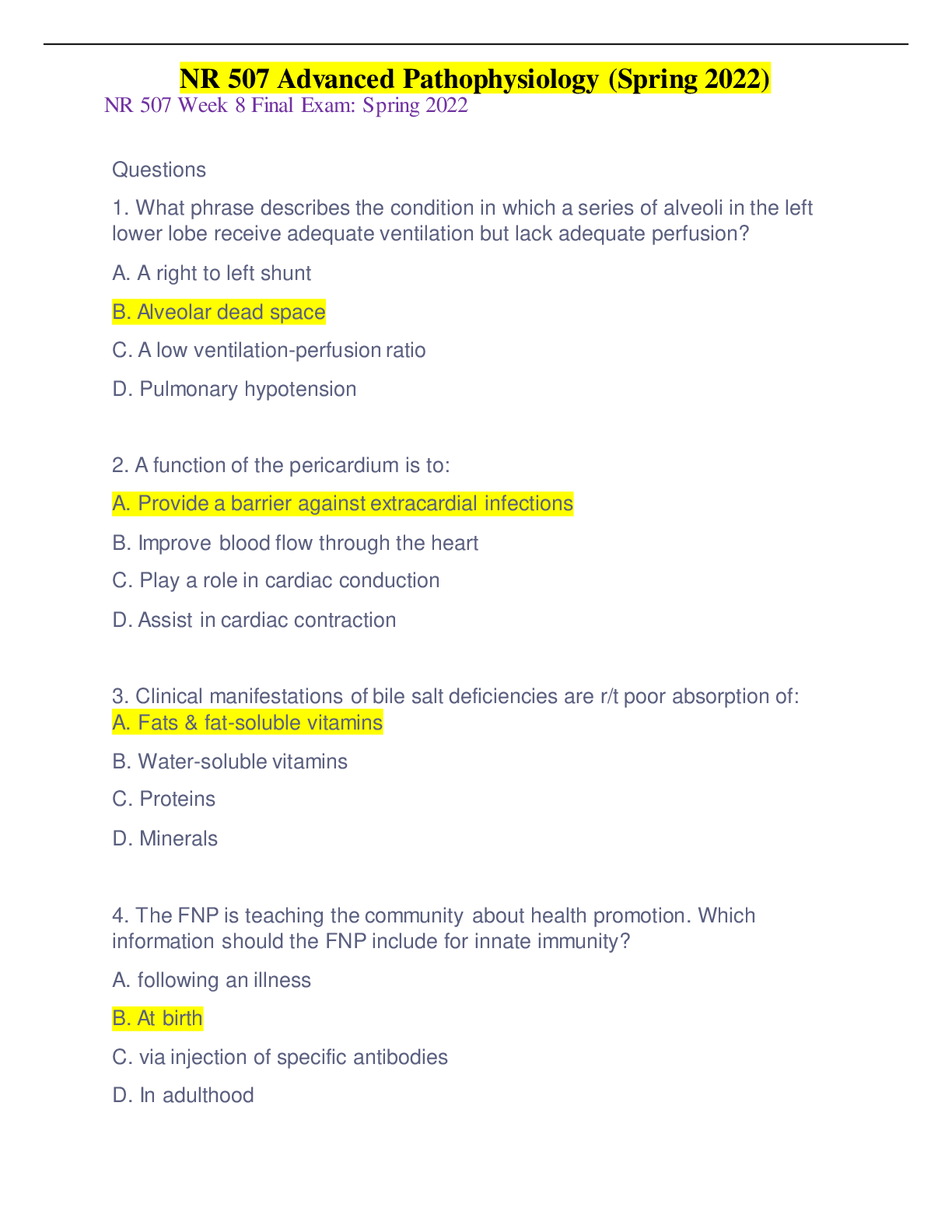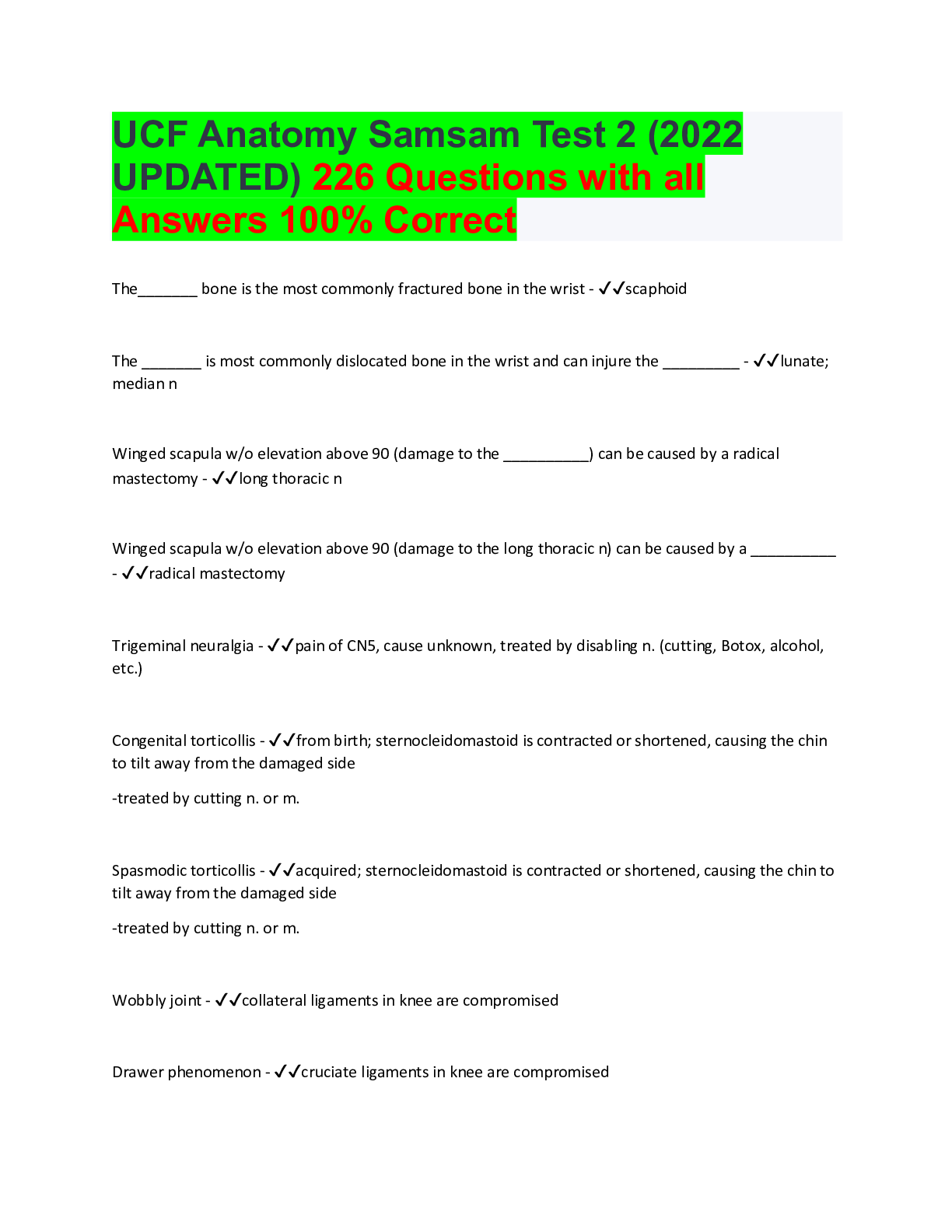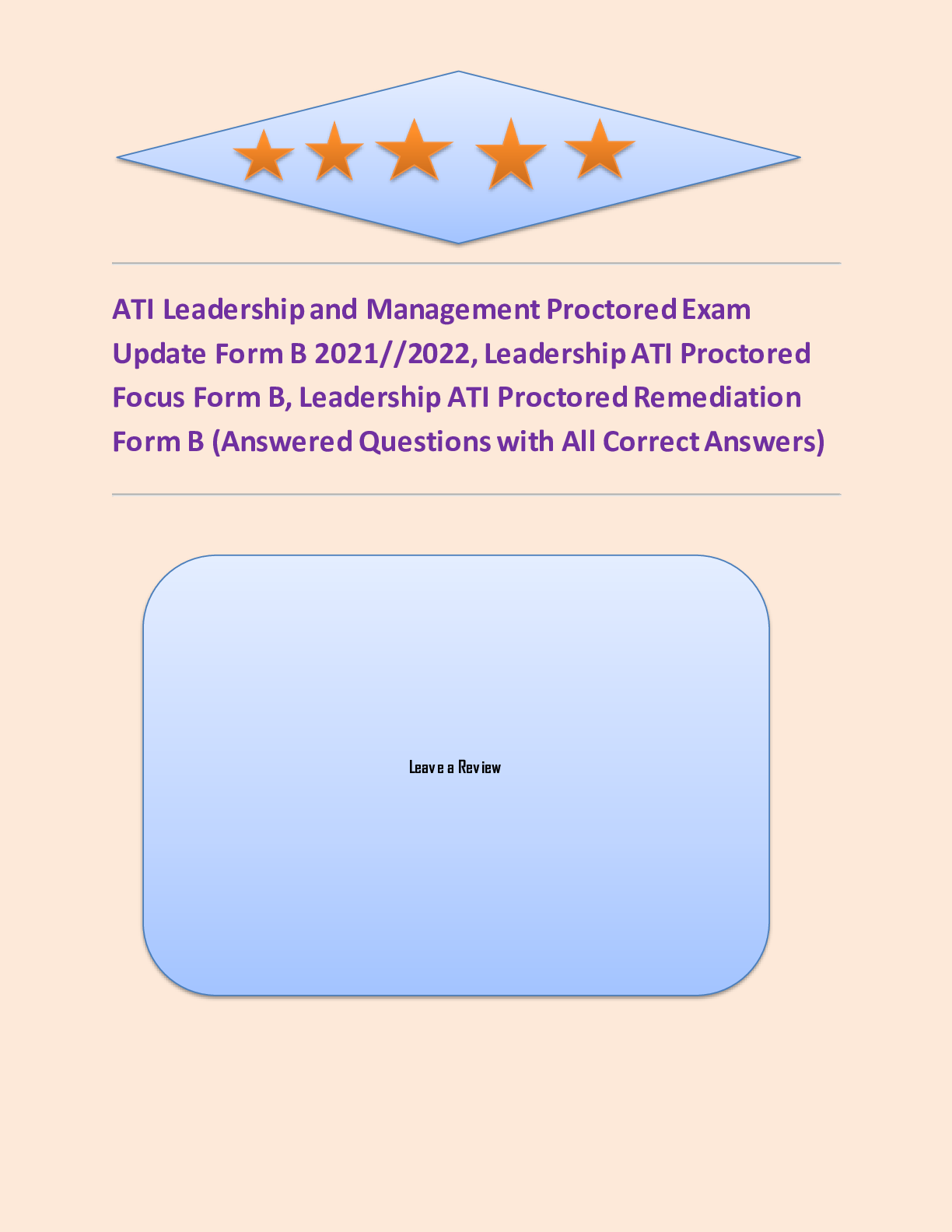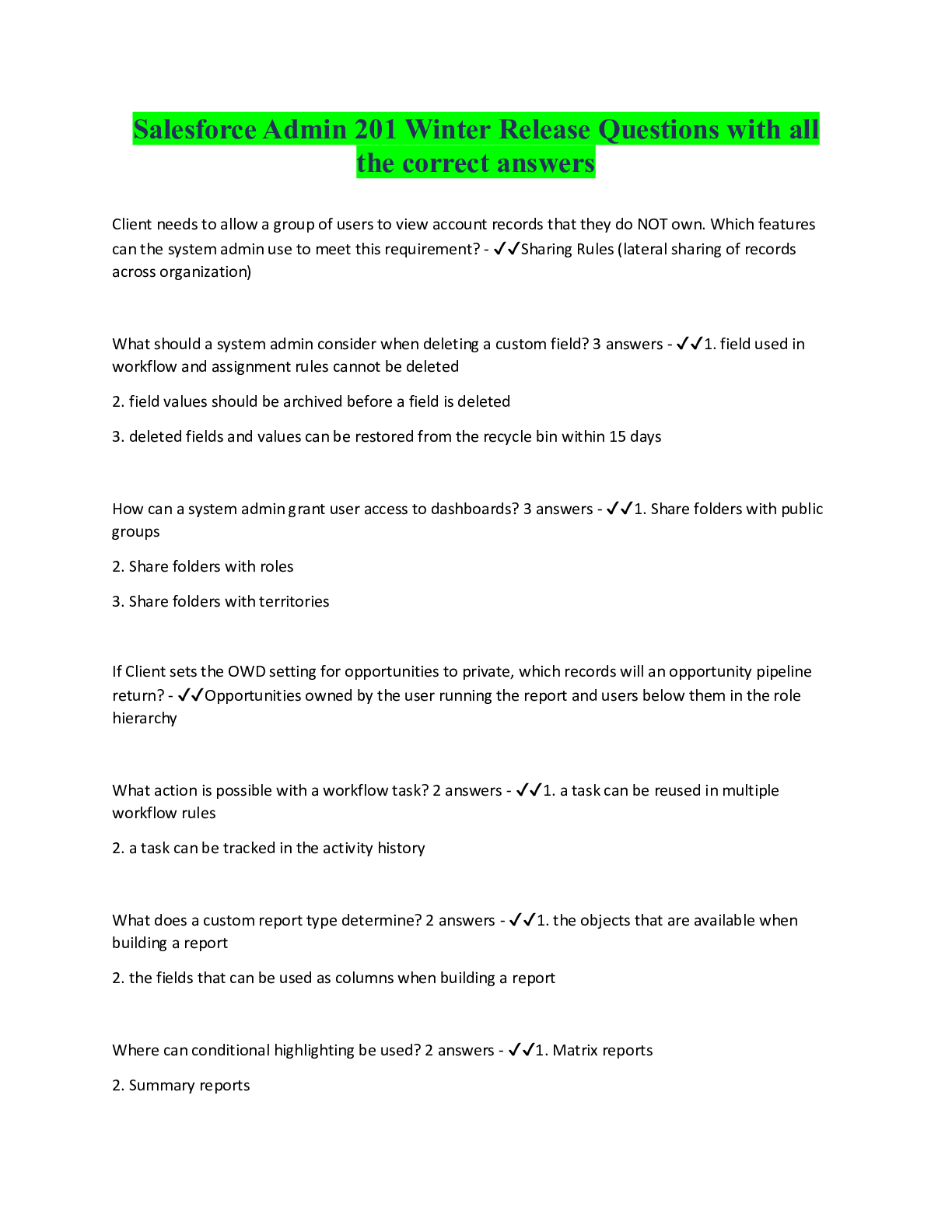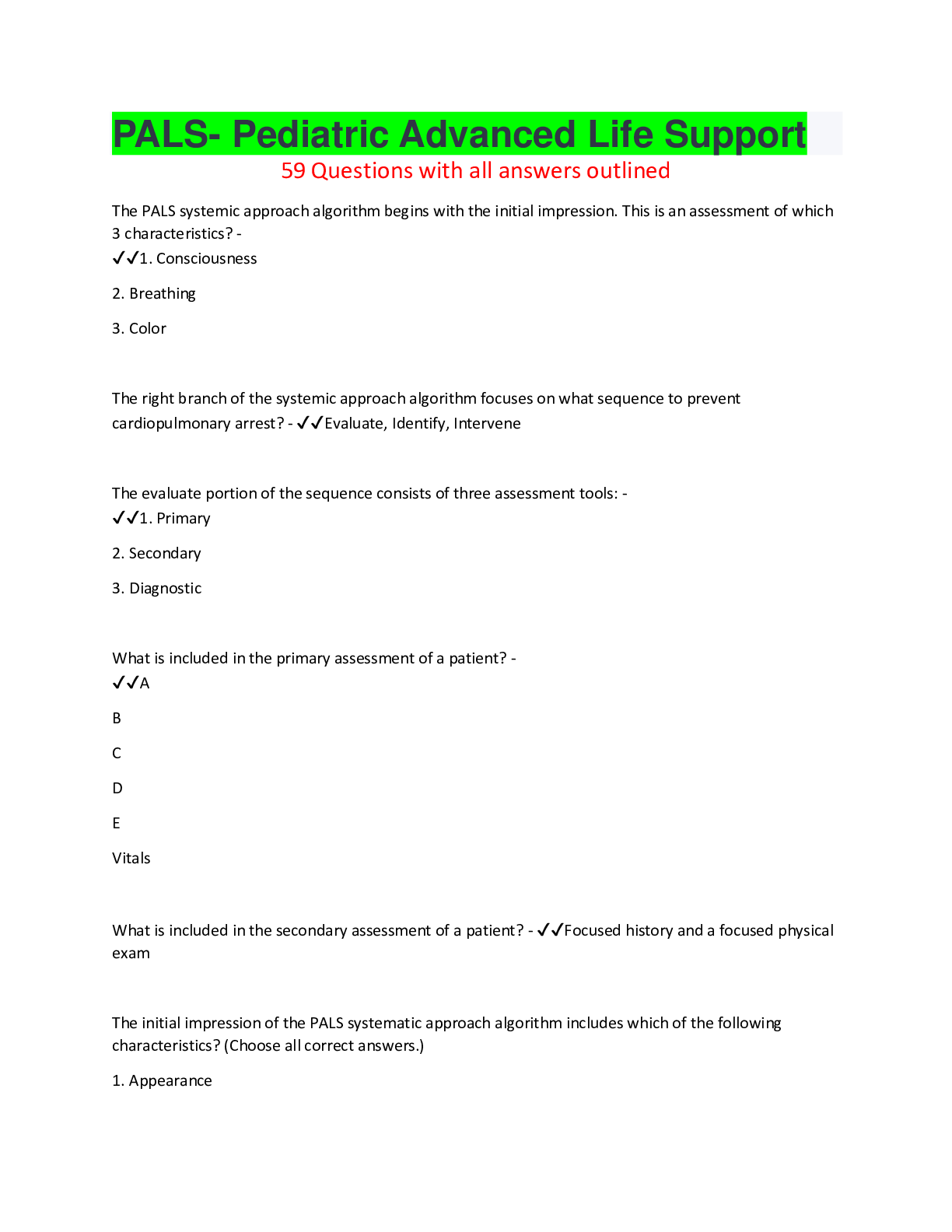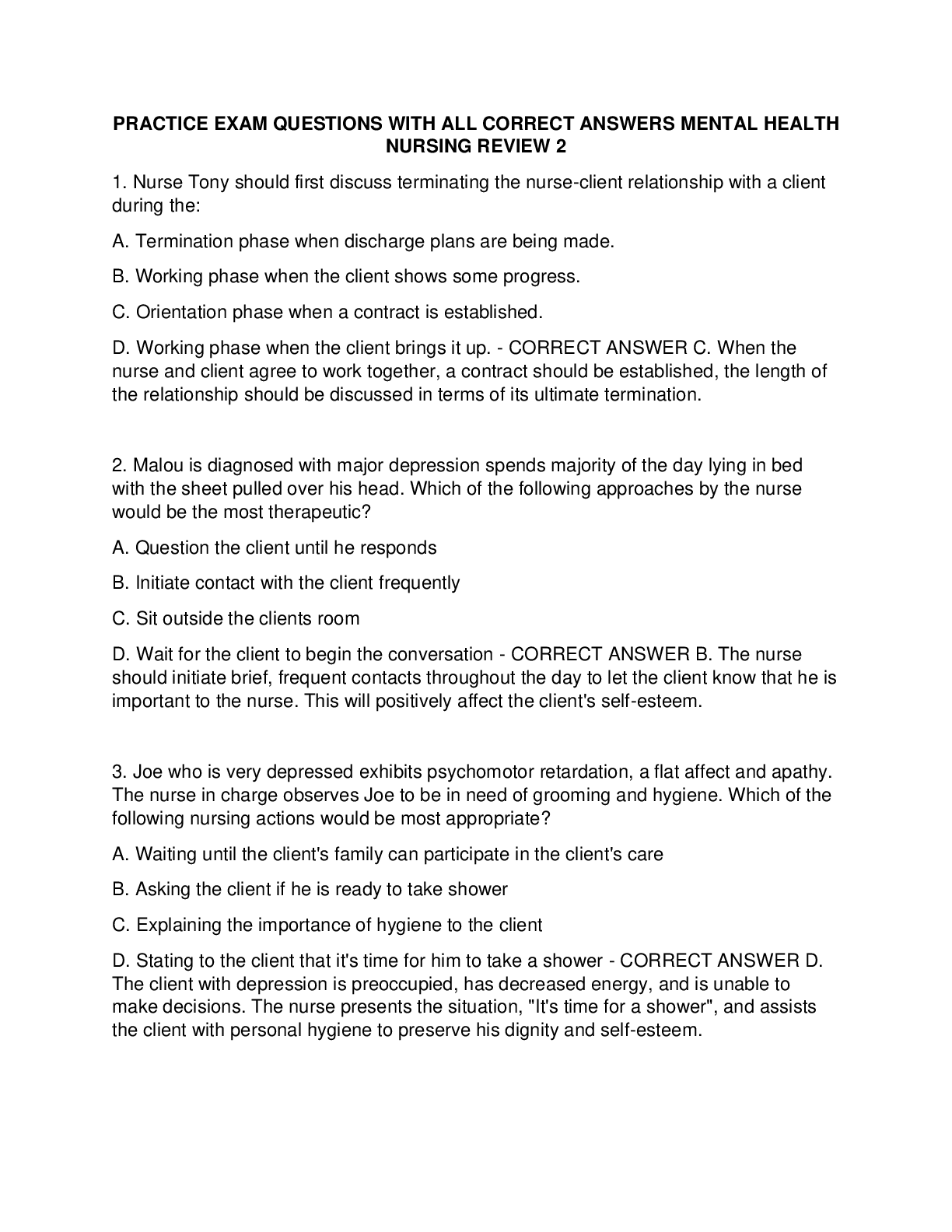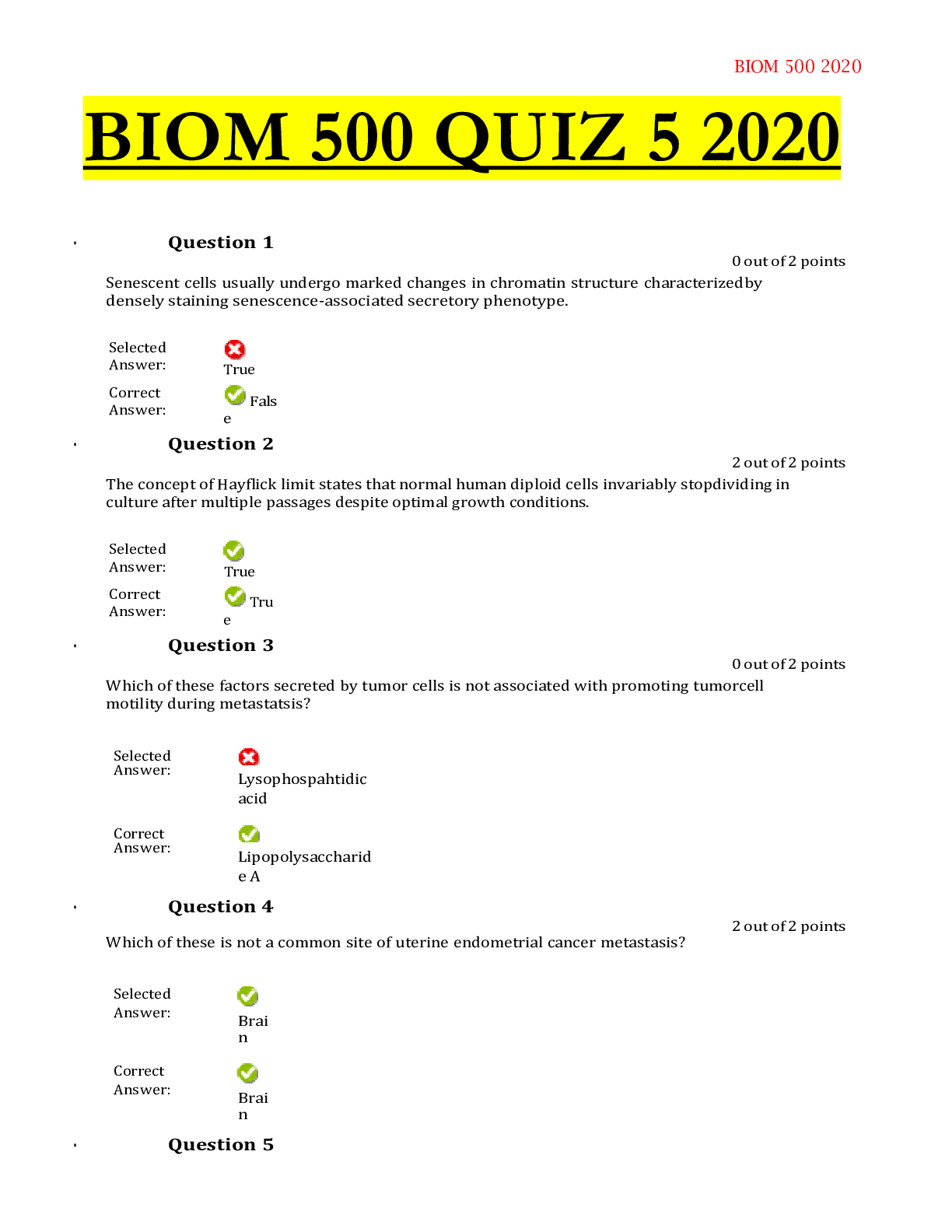HESI Pediatrics| HESI PEDS > EXAM > (Complete) 2023 HESI Pediatrics| HESI PEDS CUMULATIVE 325 Questions with All correct Answers |Verifi (All)
(Complete) 2023 HESI Pediatrics| HESI PEDS CUMULATIVE 325 Questions with All correct Answers |Verified
Document Content and Description Below
(Complete) 2023 HESI Pediatrics| HESI PEDS CUMULATIVE 325 Questions with All correct Answers |Verified Which nursing diagnosis has the highest priority when planning care for an infant with eczema? ... A. High risk for altered parenting related to feelings of inadequacy B. Altered comfort (pruritus) related to vesicular skin eruptions C. Altered health maintenance related to knowledge deficit of treatment D. Risk for impaired skin integrity related to eczema {{Correct Ans- B Rationale: Altered comfort (pruritus) has the highest priority because itching will cause the infant to scratch, creating complications such as scarring or infection. Options A, C, and D are all important nursing diagnoses and should be considered when developing the infant's plan of care, but they do not have the priority of option B. The nurse notes that a 16-year-old male client is refusing visits from his classmates. Further assessment reveals that he is concerned about his edematous facial features. Based on these assessment findings, the nurse should plan interventions related to which nursing diagnosis? A. Social isolation B. Altered health maintenance C. Knowledge deficit D. Ineffective coping {{Correct Ans- A Rationale: Peer acceptance and body image are significant issues in the growth and development of adolescents. Option A addresses the problem of a lack of contact with peers stemming from his desire to protect his ego. Options B, C, and D are not supported by the assessment finding. A child is admitted to the hospital for confirmation of a diagnosis of acute lymphoblastic leukemia. During the initial nursing assessment, which symptoms will this child most likely exhibit? A. Bone pain, pallor B. Weakness, tremors C. Nystagmus, anorexia D. Fever, abdominal distention {{Correct Ans- A Rationale: Option A lists the most common presenting symptoms of leukemia. Leukemic cells invade the bone marrow, gradually causing a weakening of the bone and a tendency toward pathologic fractures. As leukemic cells invade the periosteum, increasing pressure causes severe pain and anemia results from decreased erythrocytes, causing pallor. Options B and C could be associated with central nervous system disorders. Option D commonly occurs in children but is not specific for leukemia. A father of a 5-year-old boy calls the nurse to report that his son, who has had an upper respiratory infection, is complaining of a headache, and his temperature has increased to 103° F, taken rectally. Which intervention has the highest priority? A. Determine if the child has any allergies to antibiotics. B. Instruct the parent to give the child tepid baths. C. Instruct the parent to increase the child's fluid intake. D. Tell the parent to take the child to the emergency department. {{Correct Ans- D Rationale: The child is exhibiting symptoms that may indicate possible meningitis, and the parents should be encouraged to get immediate evaluation. Options A, B, and C are all valuable interventions after the client is assessed and diagnosed. A child with a permanent tracheostomy is confined to a wheelchair and is going to school for the first time tomorrow, During the school day, which intervention should be implemented for this child? A. Cover the tracheostomy site with clothing so that other children will not notice, B. Apply suction for 30 seconds when inserting a catheter into the stoma. C. Discourage the child from coughing deeply to remove mucous secretions. D. Place suctioning supplies on the back of the wheelchair when transporting. {{Correct Ans- D Rationale: Suctioning supplies should always be readily available for use with any client who has a tracheostomy. Options A, B, and C do not describe safe practices for this child with a tracheostomy. An 18-month-old child returns to the unit following a cardiac catheterization with a cannulated femoral artery site. Which intervention should the nurse implement? A. Teach the parents how to ambulate the child in the room safely. B. Show the parents how to hold the child with the extremity extended. C. Restrain the child's lower extremities for a minimum of 4 hours. D. Place the child in a prone position to apply pressure to the site. {{Correct Ans- B Rationale: The extremity should be extended to prevent trauma to the femoral catheterization site. Options A and D increase the risk for complications and are contraindicated. Option C is not necessary. Only the extremity that was catheterized requires immobilization. A burned child is brought to the emergency department, and the nurse uses a modified rule of nines to estimate the percentage of the body burned. When calculating the percentage of burn, which parts of the child's body are proportionally larger than an adult's? A. Head and neck B. Arms and chest C. Legs and abdomen D. Back and abdomen {{Correct Ans- A Rationale: The standard rule of nines is inaccurate for determining burned body surface areas with children because a child's head and neck are proportionately larger than an adult's. Specially designed charts are commonly used to measure the percentage of burn in children. Options B, C, and D are not proportionately different The nurse is preparing a health teaching program for parents of toddlers and preschoolers and plans to include information about the prevention of accidental poisonings. It is most important for the nurse to include which instruction? A. Tell children that they should not taste anything but food. B. Store all toxic agents and medicines in locked cabinets. C. Provide special play areas in the house and restrict play in other areas. D. Punish children if they open cabinets that contain household chemicals. {{Correct Ans- B Rationale: The only reliable way to prevent poisonings in young children is to make the items inaccessible. Teaching children not to taste anything but food is important but ineffective for young children. Options C and D will not control a child's curiosity. Which nursing interventions are therapeutic when caring for a hospitalized toddler? (Select all that apply) A. Require parents to leave the room when performing invasive procedures. B. Allow the toddler to choose a colored Band-Aid after an injection. C. Give brief but simple explanations to the child before procedures. D. Insert a urinary catheter if bedwetting occurs during hospitalization. E. Do not allow any toys to be brought in from the child's home. {{Correct Ans- Correct Answer: B,C Rationale: Giving the toddler a choice may increase autonomy in the hospitalized setting. Brief but simple explanations are beneficial with the toddler. Separation from the parent can cause emotional distress. Regression is expected, and bedwetting is not an indication for a urinary catheter. The nurse should encourage age-appropriate toys to be brought in from home. [Show More]
Last updated: 1 year ago
Preview 1 out of 78 pages
Instant download

Instant download
Reviews( 0 )
Document information
Connected school, study & course
About the document
Uploaded On
May 26, 2023
Number of pages
78
Written in
Additional information
This document has been written for:
Uploaded
May 26, 2023
Downloads
0
Views
43

